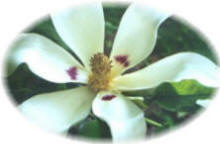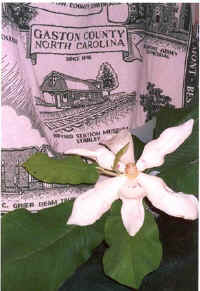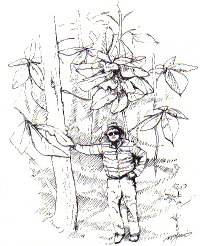


















|
The 1700's
   

Discovery of the
Large Leafed Magnolia Tree
(Magnolia macrophylla) in Stanley
 |
Photograph of the Large Leafed Magnolia,
native to Stanley
Click on the image for a full size view |
In 1785 the French Government sent
André Michaux, a botanist, to document plants and
trees in America. Samples of plants he found in the
colonies were to be sent back to France for planting
in the Royal Gardens.
After a short stay in New York and New
Jersey, Michaux settled in Charleston, South
Carolina where he established a garden for his
collections.
Michaux traveled many times back up through
the state of North Carolina and farther on into the
mountains to document plants. He kept a journal
detailing the plants he discovered. In that journal,
still in existence in 1996 housed in the Philosophical
Library in Philadelphia, PA, and still untranslated
from the original French, Michaux mentioned the
roads he traveled and names of towns and people
who welcomed him into their homes. It is believed
he came through the Stanley area at least five times.
His journal describes a journey back from the
mountains of North Carolina with a stop on the 2nd
of April 1796 at the home of Christian Reinhardt in
Lincolnton and continued as follows:
Sunday 3rd of April (1796) arrived at
Bennet Smith's, 12 miles from Lincolnton:
remained all day to pull shoots of a new
Magnolia with very large leaves, auriculate,
oblong, glaucous, silky, especially the young
leaves; the buds very silky; Flowers white
Petals with a base of purple color. Stamens
yellow, etc. Along the Creek on the bank of
which this Magnolia grows I also saw the
Kalmia Latifolia (Mountain Laurel), Viola
Lutea, filiis Hastatis (Arrow Leafed Yellow
Violet), Ulmus viscosa (Elm Tree) then in
process of fructification; Halesia (Silverbell
Tree), Stewartiapentagyna (Camellia).
The "12 miles from Lincolnton at home of
Bennet Smith" mentioned in his journal was on
Hoyle's Creek near the town of Stanley. The tree
which Andre' Michaux subsequently named the
Magnolia macrophylla, has not only the largest
simple leaves, but the largest flowers of any tree
native to temperate North America. It's giant
leaves measure up to three feet long and are often a
foot wide while the flowers sometimes reach 18
inches in diameter.
His journal continued:
The 4th - started and crossed Tuck-a-segee
ford on the Catawba River 10 miles from
Bennet Smith's. Took the road to the left
instead of passing by Charlotte and slept 11
miles from Catawba River.
Other entries in the journal of André Michaux mention staying in the home of the well
known Peter Smith.

|
A drawing of Jack C. Moore standing beneath the large leafed Magnolia trees on his property on Hoyle's
Creek. Jack owns the lands today on which André Michaux discovered the Magnolia macrophylla.
Today (1999) the trees are found, in Stanley, primarily on the property along Hoyle's Creek, and on the banks of
Stanley Creek.
(Drawing by Joe McLaurin)
|
Family tradition with the descendents of
David Smith, the son of Peter Smith, says that in
1824, when David built his beautiful home in
Lincoln County, he came back down to his father's
home on Hoyle's Creek and retrieved seedlings of
the Magnolia macrophylla and transplanted them
on the grounds of his new home, which was thereby
named Magnolia Grove.
Michaux not only sent botanical specimens
home to France, but he was responsible for
introducing to this country the Crepe Myrtle, the
Ginkgo Tree and the Mimosa Tree.
Though André Michaux was in the service
of the French Government during his eleven years
of exploration in North America, he also became
well acquainted with the politically elite of this
country such as George Washington, Thomas
Jefferson, John Adams and Alexander Hamilton.
He was, at one time, propositioned by these
men, as well as 26 other well known members of
the American Philosophical Society, to explore the
lands beyond the Appalachian Mountains to the
west and report back to them his findings. (This
being before the Lewis and Clark explorations).
Michaux declined the proposition, though
he did eventually journey to the west, but did so at
the request of France, his own country.
   
[ The Museum ] [ Contact Us ] [ Stanley History ] [ Photo Galleries ] [ Citizens ] [ Recollections ] [ Schools ] [ Churches ] [ Community ] [ Recent History ] [ Order the Books ] [ Topic Index ] [ Site Index ] [ Search ] [ Acknowledgments ] [ Related Links ] [ Guestbook ]
|
|





